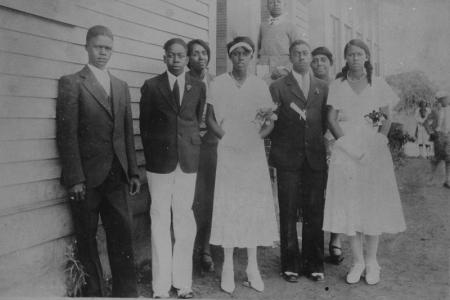School Days
School Days
Residents have shared stories about a variety of Alexandria schools and student experiences over the decades.

Courtesy of Elizabeth H. Douglas.

Memories, from the Oral History Archive
Shirley Sanderson Steele, born 1940; interviewed by Logan Wiley, August 13, 2008:
I always liked when they had the George Washington Parades…We always liked when they had those parades because Parker Gray would be in there and you had a sense of pride as you see the girls in their majorette suits.
Brice Warthen, born 1930; interviewed by Jen Hembree, November 8, 2001. Brice Warthen moved with his family to Chinquapin Village in 1941 when he was 11 years old. The community was established during World War II to provide housing for workers at the Naval Torpedo Station.
Most of our activities took place…in the schools. Because you know our schools had football teams, they had dances, and so forth. We had activities that were centered in Chinquapin. It pretty much had become, after a while, like any other community.
Maydell Casey Belk, resident of The Fort community 1952 to 1967, discusses the neighborhood’s school house; interviewed by Patricia Knock, June 6, 1994.
…it was one-story. It had a little stream in front. And a little porch, and the family that I knew remodeled everything was on one floor…It was up from the graveyard, it was their house that they turned over from the school, and then the house that I lived in was in the middle, and Clara Adams’ house was in the front…It went up to the fifth or sixth [grade].
Elizabeth Douglas, born 1919; interviewed by Patricia Knock, Dr. Henry Mitchell, and Bradford Henderlong, March 28, 1992:
So you didn’t have running water in Seminary Hills School. You had an outside toilet?
Yes, ma’am, and four rooms. We had the 8th grade, the first and second. See, in those rooms, they had two or three classes. You’d have a first and second and then you’d have third and fourth and then fifth and sixth or seventh and eighth. I went as far as I could go up there…
…we opened in the morning with a hymn. And a prayer. We had one half hour devotional every morning. One child would get up and lead the devotion. Then, we would salute the flag. “I pledge allegiance to the flag and to the republic for which it stands, one nation, indivisible, with liberty and justice for all.
Well, let me tell you. You had to be a lady or else your parents was called in.
Charles K. “Buster” Williams, born 1908; interviewed by Mitch Weinschenk, February 5, 1999:
…I went to Catholic school, St. Joseph's first. I went to St. Joseph's and I attended school and church at St. Joe's…the priest at that time was Father Kelly. He said the tuition would be twenty-five cents a week. If you didn't have twenty-five cents, to come to school anyway. So, I went to school there. We didn't go any higher than third grade. We divided the rooms off with blackboards, three rooms…I finished the third grade at that and went to Parker Gray Elementary School to the sixth. I finished the sixth grade there and went to Washington to a junior high school...
Natalie Thompson Sanks Vaughn, a teacher, vice-principal, and principal in Alexandria City Public Schools; interviewed by Patricia Knock and Henry Mitchell, July 21, 1992:
[Speaking on Dr. Martin Luther King’s assassination.] We had riots in the high school…when I went to school the next day…this woman called me and said, “They have carried on. The kids are standing all in the halls, in the front, on the lawn.” It seems they came in that next morning…and asked the principal to lower the flag to half-staff.
Celeste Coakley, born 1918, graduated in the last class of Alexandria High School; interviewed by Laina Schneider, July 24, 2007:
In high school I played basketball for four years. Our league was what it is now…Herndon, Chantilly, Oakton. That was the league the girls played in. What we usually did…the girls played the preliminary game, and the boys played the game afterward. So we always had to be there early, because we kicked it off.
June Barry, born in the 1930s; interviewed by Jennifer Landy and Chris Gagne, May 14, 2010:
The football season was really the high season at G-W. They had what they called the “Old Oaken Bucket”...Whoever won the Thanksgiving Day game between Washington and Lee [in] Arlington [Washington-Liberty High School today] and G-W got to keep the “Old Oaken Bucket.
Another thing we did from school was the skating rink...It was on Washington Street going towards D.C...They had a man that played the organ. Everybody wore skating skirts...They would dance on skates. That was very popular. And the Hot Shoppe. All the kids from G-W went to the [Hot Shoppe]...It’s right there, right where the skating rink was. And they had a drive-in. Drive up in your car. Nobody ever went on a date from G-W that they didn’t go to the Hot Shoppe after the date.”
Yolie Carrasco, interviewed with Mildred Rivera, discussing the programs they presented to Alexandria school children about autism and other disabilities; interviewed by Leah Spellman, April 17, 2017:
And we know that it's important for typical kids to see kids with special needs 'cause I think the typical kids get more out of it, because it teaches them to be empathetic; to have, um, concerns, to have a moral compass, you know, and it's important for everyone, that's what I think.